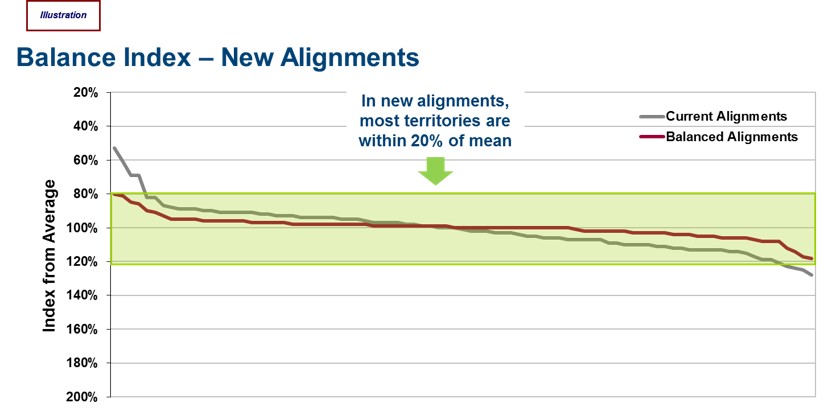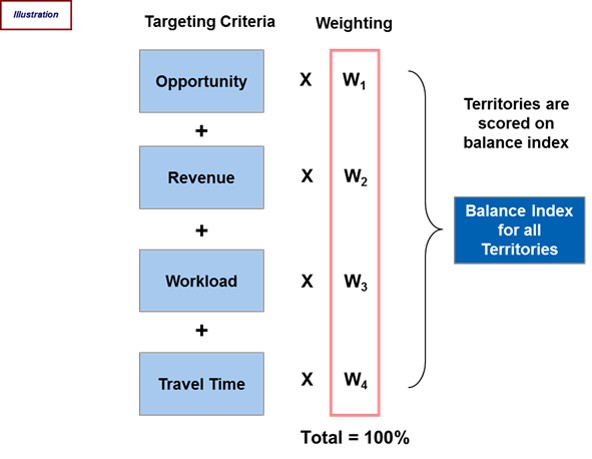Do sales reps or territories drive performance?

You’ve probably seen this story before. The President’s Club trip is filled with reps who hold the prized sales territories. Maybe they “earned” the right to those territories based on past performance, but are they top performers today? And even if they were, is this fair? Or a better question, is this the best allocation of sales resources?
All too often territory design has a bigger impact on sales rep performance than effort or selling skills. Territory design failure can come in several forms, but let’s consider the two most common scenarios:
High Market Share Bias: This classic scenario has top performers comfortably perched over the largest, most well established territories with a large incumbent base of business. They are able to drive growth by leveraging their strong market presence and relationships, earning their coveted seats at President’s Club year after year. Meanwhile, the reps assigned to “greenfield” territories work twice as hard to generate half the sales. They hunt for new accounts and work hard to establish new relationships, but the results of their work may not be seen right away, so their efforts don’t earn them Club status.
Low Market Share Bias: There are also situations where the opposite may be true. Particularly when reps are measured on growth, and having a lot of existing customers causes the rep to get “bogged down” in account management work, taking precious time away from hunting. Consider this real-life example of a superstar sales rep in a very high opportunity territory. The sales representative grew his territory at a rate of twice his peers, but the territory’s market share was half the company average. To make matters worse, all President’s Club winners in this case came from relatively low market share territories. These low share territories also benefited from low volume. Not only did these territories have plenty of opportunity, the sales reps also had lower workloads. This freed sales representatives from the burdensome task of maintenance selling. Hence, low share territories were free to hunt for new business and had the sales time required to drive growth.
In both examples, high performance was largely influenced by territory design. In order to make President’s Club, in one case a relatively high share territory was required; in the other case, a low share territory was required. Does your sales organization suffer from territory design-induced performance biases? If so, territory optimization is the answer. Territory optimization seeks to balance seller capacity and market opportunity while minimizing disruption. Effective optimization can drive 10-20 percent incremental growth with relatively minimal investment.
There are a few typical triggers which drive the need for territory optimization, including:
- Double digit sales growth
- New product launches
- Sales force size increases
- Investment in new roles
- Mergers and acquisitions
- Sub-optimized sales rep workloads
If any of these scenarios apply to you, territory optimization is not an option, it’s a requirement. Best-in-class sales organizations optimize territories to enhance the effectiveness of their sellers and the associated performance management system. There is a five-step system to optimizing territories.
- Step 1 – Define the variables that matter most
- Step 2 – Weigh each variable appropriately
- Step 3 – Calibrate the index
- Step 4 – Review results and disruption
- Step 5 – Rebalance appropriate territories
Defining the most appropriate variables and the relative importance of each variable establishes the measuring stick. The most highly utilized variables for index construction include opportunity, revenue, workload and travel time. The appropriate weighting of each variable is driven by sales job design, sales process complexity, and quality of available data. The average territory across all values typically receives an index score of 100. The following illustration depicts a typical territory balancing index.
Once the index is established, analysis is required to identify territories that are outside of the optimal range, typically plus or minus 20 percent of the average index value. For those territories that fall outside of the range, those territories require rebalancing. Here is an illustration that depicts before and after results.

During the territory balancing process it’s critical to incorporate input from sales management. They can provide insight into account relationships, local market dynamics and rep skill level. Sales management input also ensures buy-in and is a critical element of the change management process.
Rebalancing territories utilizing key quantifiable variables levels the playing field. In optimized territories biases are removed, and seller skill as well as effort better define performance. In addition, territory balancing efforts optimize sales capacity. In many cases, optimization efforts can free your best sellers from the constraints of maintenance selling. Optimization efforts provide all territories with the sales time and potential to drive growth.
Best-in-class sales organizations review territory structure on an annual basis. Territory optimization reviews are typically included in the annual planning process. The annual sales planning season is fast approaching, and if you want to maximize the efficiency of your sales organization, make territory optimization a priority. Territory optimization is a highly effective tool to unlock hidden growth capacity.
Contact Craig Ackerman or Mike Burnett who lead Alexander Group’s Sizing and Territory Design practice.

Contact Us To Learn More
How can the Alexander Group help you balance your territories? Learn more about our sizing and deployment practice or speak with our experts!

